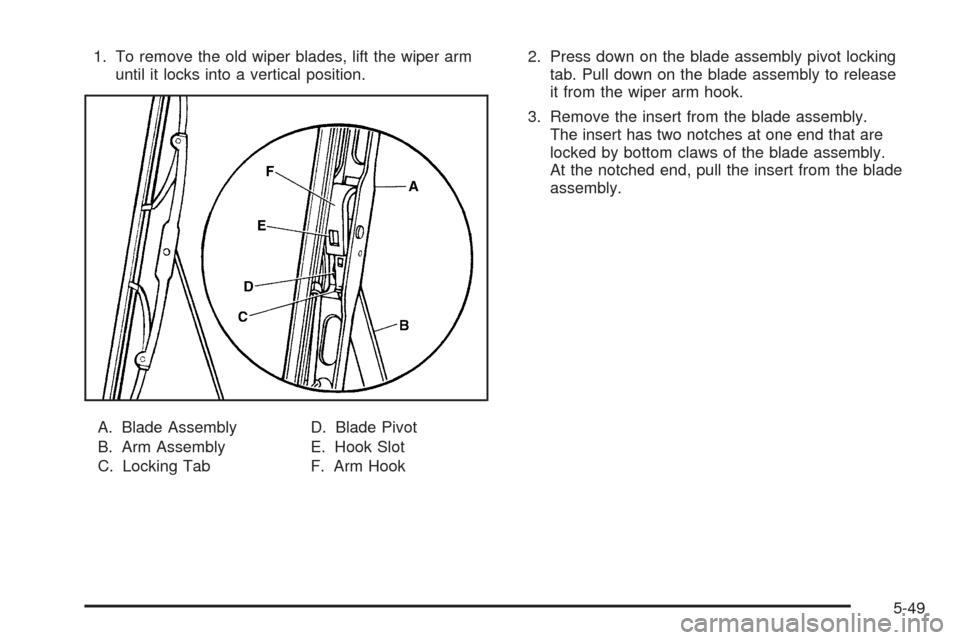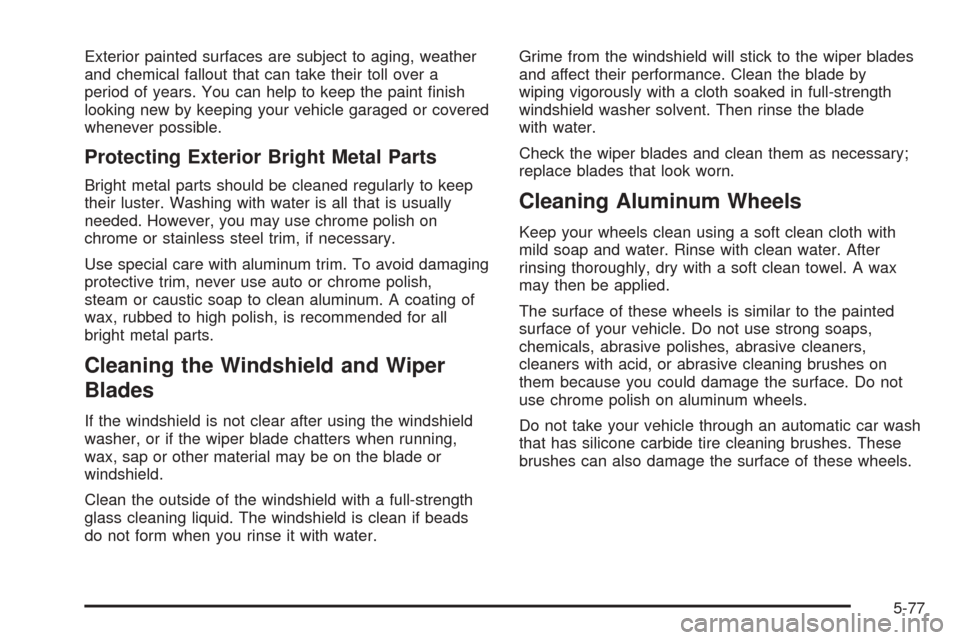2003 CHEVROLET SSR wiper blades
[x] Cancel search: wiper bladesPage 203 of 374

Driving in Rain and on Wet Roads
Rain and wet roads can mean driving trouble. On a wet
road, you cannot stop, accelerate, or turn as well
because your tire-to-road traction is not as good as ondry roads. And, if your tires do not have much tread left,
you will get even less traction. It is always wise to go
slower and be cautious if rain starts to fall while you are
driving. The surface may get wet suddenly when your
re�exes are tuned for driving on dry pavement.
The heavier the rain, the harder it is to see. Even if your
windshield wiper blades are in good shape, a heavy
rain can make it harder to see road signs and
traffic signals, pavement markings, the edge of the road,
and even people walking.
It is wise to keep your wiping equipment in good shape
and keep your windshield washer tank �lled with
washer �uid. Replace your windshield wiper inserts
when they show signs of streaking or missing areas on
the windshield, or when strips of rubber start to
separate from the inserts.
4-17
Page 209 of 374

Here are some things you can check before a trip:
Windshield Washer Fluid:Is the reservoir full? Are
all windows clean inside and outside?
Wiper Blades:Are they in good shape?
Fuel, Engine Oil, Other Fluids:Have you checked
all levels?
Lamps:Are they all working? Are the lenses clean?
Tires:They are vitally important to a safe,
trouble-free trip. Is the tread good enough for
long-distance driving? Are the tires all in�ated to the
recommended pressure?
Weather Forecasts:What is the weather outlook
along your route? Should you delay your trip a
short time to avoid a major storm system?
Maps:Do you have up-to-date maps?
Highway Hypnosis
Is there actually such a condition as highway hypnosis?
Or is it just plain falling asleep at the wheel? Call it
highway hypnosis, lack of awareness, or whatever.
There is something about an easy stretch of road with
the same scenery, along with the hum of the tires on the
road, the drone of the engine, and the rush of the
wind against the vehicle that can make you sleepy. Do
not let it happen to you! If it does, your vehicle can
leave the road in less than a second, and you could
crash and be injured.
What can you do about highway hypnosis? First, be
aware that it can happen.
Then here are some tips:
Make sure your vehicle is well ventilated, with a
comfortably cool interior.
Keep your eyes moving. Scan the road ahead and
to the sides. Check your mirrors and your
instruments frequently.
If you get sleepy, pull off the road into a rest,
service, or parking area and take a nap, get some
exercise, or both. For safety, treat drowsiness
on the highway as an emergency.
4-23
Page 284 of 374

Replacement Bulbs
Exterior Lamp Bulb Number
Back-up Lamps 2057
Headlamps
High-Beam 9005HB3
Low-Beam H11
Parking Lamps T20
Sidemarker Lamps 194
Taillamps 3157
Turn Signal Lamps T20
For replacement bulbs not listed here, contact
your dealer.
Windshield Wiper Blade
Replacement
Windshield wiper blades should be inspected at
least twice a year for wear and cracking. See “Wiper
Blade Check” underAt Least Twice a Year on page 6-9.
Replacement blades come in different types and are
removed in different ways. For proper type and length,
seeNormal Maintenance Replacement Parts on
page 5-91.
Notice:Allowing the wiper blade arm to touch
the windshield when no wiper blade is installed
could damage the windshield. Any damage
that occurs would not be covered by your warranty.
Do not allow the wiper blade arm to touch the
windshield.
5-48
Page 285 of 374

1. To remove the old wiper blades, lift the wiper arm
until it locks into a vertical position.
A. Blade Assembly
B. Arm Assembly
C. Locking TabD. Blade Pivot
E. Hook Slot
F. Arm Hook2. Press down on the blade assembly pivot locking
tab. Pull down on the blade assembly to release
it from the wiper arm hook.
3. Remove the insert from the blade assembly.
The insert has two notches at one end that are
locked by bottom claws of the blade assembly.
At the notched end, pull the insert from the blade
assembly.
5-49
Page 313 of 374

Exterior painted surfaces are subject to aging, weather
and chemical fallout that can take their toll over a
period of years. You can help to keep the paint �nish
looking new by keeping your vehicle garaged or covered
whenever possible.
Protecting Exterior Bright Metal Parts
Bright metal parts should be cleaned regularly to keep
their luster. Washing with water is all that is usually
needed. However, you may use chrome polish on
chrome or stainless steel trim, if necessary.
Use special care with aluminum trim. To avoid damaging
protective trim, never use auto or chrome polish,
steam or caustic soap to clean aluminum. A coating of
wax, rubbed to high polish, is recommended for all
bright metal parts.
Cleaning the Windshield and Wiper
Blades
If the windshield is not clear after using the windshield
washer, or if the wiper blade chatters when running,
wax, sap or other material may be on the blade or
windshield.
Clean the outside of the windshield with a full-strength
glass cleaning liquid. The windshield is clean if beads
do not form when you rinse it with water.Grime from the windshield will stick to the wiper blades
and affect their performance. Clean the blade by
wiping vigorously with a cloth soaked in full-strength
windshield washer solvent. Then rinse the blade
with water.
Check the wiper blades and clean them as necessary;
replace blades that look worn.
Cleaning Aluminum Wheels
Keep your wheels clean using a soft clean cloth with
mild soap and water. Rinse with clean water. After
rinsing thoroughly, dry with a soft clean towel. A wax
may then be applied.
The surface of these wheels is similar to the painted
surface of your vehicle. Do not use strong soaps,
chemicals, abrasive polishes, abrasive cleaners,
cleaners with acid, or abrasive cleaning brushes on
them because you could damage the surface. Do not
use chrome polish on aluminum wheels.
Do not take your vehicle through an automatic car wash
that has silicone carbide tire cleaning brushes. These
brushes can also damage the surface of these wheels.
5-77
Page 338 of 374

Wiper Blade Check
Inspect wiper blades for wear or cracking. Replace
blade inserts that appear worn or damaged or that
streak or miss areas of the windshield. Also see
Cleaning the Outside of Your Vehicle on page 5-75.
Weatherstrip Lubrication
Silicone grease on weatherstrips will make them last
longer, seal better, and not stick or squeak. Apply
silicone grease with a clean cloth. During very cold,
damp weather more frequent application may be
required. SeePart D: Recommended Fluids and
Lubricants on page 6-15.
Automatic Transmission Check
Check the transmission �uid level; add if needed. See
Automatic Transmission Fluid on page 5-21. A �uid loss
may indicate a problem. Check the system and repair
if needed.
At Least Once a Year
Key Lock Cylinders Service
Lubricate the key lock cylinders with the lubricant
speci�ed in Part D.
Body Lubrication Service
Lubricate all body door and fuel door hinges, latches
and locks, including the glove box and console
doors, the body hood, secondary latch, pivots, spring
anchor, release pawl and any moving seat hardware.
Lubricate the hood safety lever pivot and prop rod pivot.
Part D tells you what to use. More frequent lubrication
may be required when exposed to a corrosive
environment.
6-10
Page 361 of 374

Certi�cation/Tire Label.....................................4-35
Chains, Tire...................................................5-64
Change Trans (Transmission) Fluid....................3-46
Charging System Light....................................3-27
Check
Engine Light...............................................3-30
Gages Warning Light...................................3-36
Check Engine Light.........................................3-30
Check Oil Level..............................................3-46
Checking Brake Fluid......................................5-34
Checking Coolant............................................5-26
Checking Engine Oil........................................5-14
Checking the Automatic Transmission
Fluid Level.................................................5-23
Checking Things Under the Hood......................5-10
Chemical Paint Spotting...................................5-78
Child Restraints
Child Restraint Systems...............................1-25
Infants and Young Children...........................1-22
Lower Anchorages and Top Tethers for
Children (LATCH System)..........................1-31
Older Children.............................................1-20
Securing a Child Restraint Designed for the
LATCH System........................................1-33Child Restraints (cont.)
Securing a Child Restraint in the Passenger
Seat Position...........................................1-36
Top Strap...................................................1-29
Top Strap Anchor Location............................1-31
Cigarette Lighter.............................................3-17
Cleaning
Inside of Your Vehicle..................................5-73
Outside of Your Vehicle................................5-75
Underbody Maintenance...............................5-78
Weatherstrips..............................................5-75
Cleaning Aluminum Wheels..............................5-77
Cleaning Exterior Lamps/Lenses.......................5-76
Cleaning Fabric/Carpet....................................5-73
Cleaning Glass Surfaces..................................5-75
Cleaning Interior Plastic Components.................5-75
Cleaning Leather............................................5-74
Cleaning the Top of the Instrument Panel...........5-75
Cleaning the Windshield and Wiper Blades.........5-77
Cleaning Tires................................................5-78
Cleaning Vinyl................................................5-74
Climate Control System...................................3-18
Outlet Adjustment........................................3-21
Content Theft-Deterrent....................................2-12
3